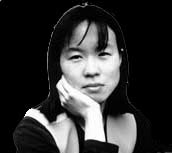
image taken from Press Gang's webpage |
|

image taken from Press Gang's webpage |
|
![]()
Characters and Structure:
|
|
|
|
|
|
I) Examples of Patriarch/Colonial control:
--transformation: from animal-eating, to animating the dead. Here she focuses a lot on women, from helping them, to having sex with them (e.g. helping the wife in the first story),II. Identity: fragmentation and reconstructions
-- Journey to the West
-- to animate a dead body and then living body, and then focus on Yu.
--not only feminist, but lesbian (see below)
Artemis' imagination--crossing boundaries; e.g. with older eyes--tanks around 85, her view of Saint's eys
(Deborah Wills--Mount Allison University, Sackville, New Brunswick, Canada
E0A 3C0)
*We would like to thank Deborah here for her agreement to give us her
conference paper, and her persistent efforts in doing so via-email.
| three sections: "Fluidity"; "Fixity," and "Being Transfixed."
"Fluidity"--"The matrix of this space of liminality and contiguity, this gap between "between" and across," is offered as an ambivalent space of violence, sensuality, and metamorphosis." e.g. confusion of identity markers, masquerade, doubling "Fixity"--"[Fox] takes on the whole of recorded history as inadequate, oppressive, and exclusionary: a master narrative that masters its subjects by pinning them down in false or incomplete stories or exiling them altogether." e.g. official history, museum, art collector --"the pageantry, costumes, and disguises in which the characters revel offer no quick fixes: instead, even they may lead to stasis, to fixity." "Being Transfixed"--"I have tried to acknowledge this by adding the prefix "trans" to my previous term 'fixed'; by doing this I want to recognize both the way that this ambivalent process works along and across lines and boundaries, and also to admit the twist the Lai gives to the idea of fixation." e.g. marginal bodies, "each character is not only transformed but transfixed: frozen in the gaze of a dangerous lover, ..." |